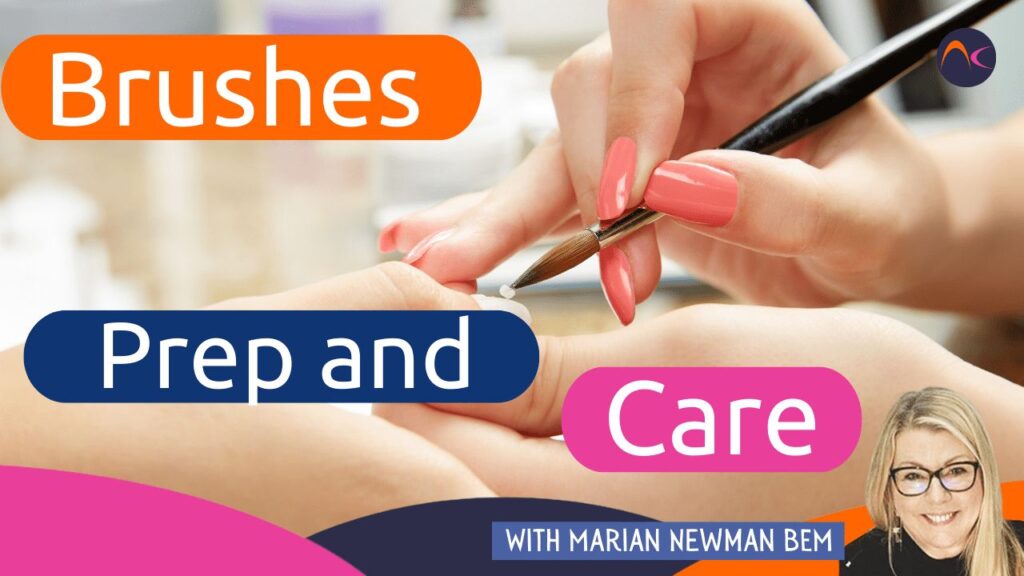Los pinceles para uñas son una herramienta esencial para los profesionales de la manicura
Los pinceles son herramientas clave para todo profesional de las uñas. Pero, ¿cómo elegirlos, prepararlos para su uso y cuidarlos para que sean eficaces y duraderos?
Let us help…..
Elegir el cepillo de uñas adecuado
First of all, understand that it is a false economy to buy cheap! As with most purchases, you get what you pay for. Finding inexpensive sets on the internet means that you will get poor-quality brushes that won’t perform well and will not last long!
Compra a un proveedor de confianza. Un buen lugar para comprar es una marca conocida por sus galardonados artistas de uñas. Habrán probado muchos pinceles y se habrán decidido por el que creen que es el mejor tanto para el trabajo como para la longevidad.
Compra los más caros que puedas permitirte y, con cuidado, te durarán años. Cómpralos baratos y solo te durarán unas semanas.
Preparación de cepillos de uñas de calidad
All new quality brushes have a ‘dressing’ in the bristles that needs to be removed. Especially natural hairbrushes for L&P and art.
Pinceles artísticos
- Frotar entre los dedos, lo que eliminará una especie de polvo.
- Lavar en agua tibia con un toque de jabón aclarar bien y secar entre un pañuelo de papel.
- Dejar secar natural y completamente antes de usar.
- Hazlo con regularidad para limpiarlos bien.
- Como son pelos naturales, puedes usar un puntito de acondicionador y aclarar muy bien.
L&P Brushes (they will probably be the most expensive brushes you’ll buy. Kolinski sable nail brushes are the best you can buy. The shape of the hair in the main part of the brush (the belly) that can hold a lot of liquid and gives you immense control of your bead ratio.
It takes a while to get used to a new brush e.g., how far to dip it into the liquid monomer, how hard to drain the brush, and how to dip it into the powder.
Correct bead control and ratio should mean that you never need to dip into monomer again during application. Knowing your brush means that you can hold some extra liquid in the belly and ‘feed the bead’.
Prueba estos sencillos pasos si te resulta demasiado seco
- Rub the brush between your fingers to remove some of the ‘dust’.
- Vierta una pequeña cantidad de monómero en un plato.
- Dip the brush into the liquid and bring it straight out (don’t wipe on the side).
- Secar en un pañuelo de papel.
- Repítelo un par de veces.
- Press the brush into the base of the dish which will expel air bubbles.
- Vierta el líquido restante en pañuelos y retírelo con seguridad.
- Realice los pasos 6 y 7 al principio de cada día para preparar el cepillo para el primer uso.
- Da forma al pincel pasándolo por un pañuelo de papel hasta que tenga una forma perfecta con una punta fina.
- Guarde el cepillo en posición horizontal en una caja tapada.
- DO NOT store in a pot upside down. This will allow the monomer in the brush to run into the metal band holding the hairs. This will be old and impure monomer that will run back into the brush and cause a discolored overlay.
- Limpia el cepillo como se describe aquí cada dos días para mantenerlo en buen estado.
- No utilice nunca los dedos para dar forma al pincel.
- Nunca limpie el pincel en otra cosa que no sea monómero.
- If it has lumps of L&P stuck in it, suspend it in monomer overnight and the lumps will disappear. If they don’t then you need to buy a new brush which is avoidable and expensive.
Pinceles para gel UV
UV Gel brushes are always nylon due to their contact with solvents that natural hairs cannot cope with. They still have a ‘dressing’
- They can be dipped in IPA and left to dry.
- Un método mejor es utilizar un disco de algodón con reverso de plástico. Coge una pequeña gota de gel UV transparente y aplícala en el pincel por el lado del plástico.
- Esto doblará las cerdas y las hará más manejables.
- To clean only use IPA. Any cured gel stuck in them can be removed by soaking them in some acetone for a few hours
Cepillos para polvo
Dust brushes are popular but need careful handling as they can be full of pathogens and natural oils that get deposited on an unfinished coating.
Si son de pelo natural, límpielos con la misma regularidad que los pinceles artísticos. Los de plástico o silicona pueden lavarse con agua y jabón.
Con todos los cepillos, haga una buena elección y una buena inversión y luego, cuide su inversión.


